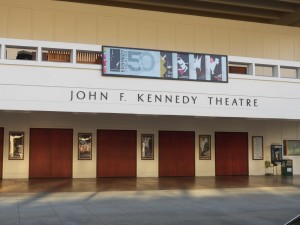By Angeline Han
Contributing writer
—-
The director of the “Wild Party” musical doesn’t want you to be comfortable. While watching the performance, that is. As part of her thesis, Brittni Michele Shambaugh chose to direct a musical that isn’t “jazz hands and bright colors”, instead opting to present a musical play that speaks a truth that people will have a visceral reaction to.
From the Oct. 23 to the 26 at 8 p.m. and the 27 at 2 p.m., and even extended performances on Nov. 1, 2, and 3, “Wild Party” was performed at UH Mānoa’s John F. Kennedy Theatre.
Set in the 1920s, Queenie, a vaudeville dancer, and her boyfriend Burrs have a tempestuous relationship where they drive each other to their limits. They throw a party intending to make each other jealous, and when Queenie’s friend Kate brings an intriguing man it really stirs up the current, resulting in – a wild party. But it’s not all frivolity and gaiety.
“It’s about a struggle to find happiness.” Shambaugh said. “All these characters are really desperately trying to find happiness, trying to make themselves happy, but in that desperation they’re choosing really unhealthy means of getting there.”
The heavy material of the play is juxtaposed with the exuberant dance numbers and songs, making it a unique juggling act for the actors and behind the scenes with the choreographers as well. Michelle Johnson, the main choreographer was moving to Canada while “Wild Party” was in production.
Another choreographer, Kathryn Holt, offered to co-choreograph for Johnson; Holt would show the dance numbers via video chat and Johnson would critique and say where moves could be added or made better. The week before opening night Johnson flew into Honolulu to tighten up the routines. Expect a lot of swing dancing and tap dancing, but no Charleston, which Johnson felt was hackneyed and used too often as a fallback.
“I challenged myself to not use any Charleston,” Johnson said.
The actors had challenges of their own.
“[We’re asking the actors] to do these really complicated 1920s dance moves while singing a 12-part harmony while also breaking everyone’s hearts,” Shambaugh said. “And make it look like you’re having fun.” she added with a laugh.
The atmosphere of “Wild Party” will be more intimate than most musicals or plays, because the action takes place entirely in the Queenie and Burrs’ living room. Set on a circular stage with seating close up, the actors will interact with the audience, harking back to traditional vaudeville where improvisation and audience participation were key to the performance.
Shambaugh encourages people attending the play dress in ‘20s fashion so that they feel a part of what is going on. On the 26th there was a special after-show talk with the director and the cast giving the audience an in-depth view of “Wild Party”.
These characters are achingly real in the sense that you can’t put labels on them of evil and virtuous, but just humans making errors and discovering life lessons.
Shambaugh worked with some of her cast members previously and has close relationships with a few, making it rewarding but sometimes difficult. She mentioned how it can be tough to be an authority figure on stage in order to get a certain outcome in work, but the close-knit feeling has lent to a spirit of collaboration.
When it comes to her craft she isn’t keen on warm fuzzy pablum.
“Every show that I’ve ever directed, people have left at intermission.” Shambaugh said.
“Not because they’re bad shows, but because it’s not for everybody. I intentionally choose material that’s going to be challenging, as a performer and as an audience member. I feel if somebody is feeling uncomfortable and doesn’t want to watch the whole thing that’s their prerogative,” she said. “I don’t mind if people leave the show and they’re like ‘I hated that’ as long as they hate it because they didn’t like the way it made them feel, as opposed to they hated it because it wasn’t well done.”
Ultimately, Shambaugh wants people to come to the play with an open mind, whether they love it or hate it.
“I’m not trying to tell you how to feel,” she said. “But I just want you to come in willing to be a part of it and experience it with us.”

